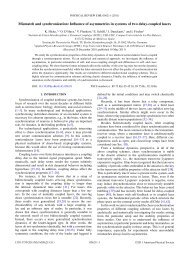DBI Analysis of Open String Bound States on Non-compact D-branes
DBI Analysis of Open String Bound States on Non-compact D-branes
DBI Analysis of Open String Bound States on Non-compact D-branes
Create successful ePaper yourself
Turn your PDF publications into a flip-book with our unique Google optimized e-Paper software.
CHAPTER 4. CONFORMAL INVARIANCE 57dealt with, the anti-symmetric Kalb-Ram<strong>on</strong>d field B µν and the dilat<strong>on</strong> field Φ. These aresometimes referred to as the universal factor. So we should also find a way to incorporatethese last two fields in our acti<strong>on</strong> since they are equally part <str<strong>on</strong>g>of</str<strong>on</strong>g> the background. Ourprevious recipe can be applied without too much difficulty to the B µν field, 6S B = − 14πα ′ ∫d 2 σǫ αβ B µν (X) ∂ α X µ ∂ β X ν , (4.16)in which ǫ αβ is the usual anti-symmetric tensor density with comp<strong>on</strong>ents ǫ 01 = −ǫ 10 = 1and ǫ 00 = ǫ 11 = 0, but the dilat<strong>on</strong> coupling is c<strong>on</strong>siderably more subtle. The right wayto incorporate it turns out to beS Φ = − 14π∫d 2 σ √ −hΦ(X) R (2) , (4.17)in which R (2) again represents the world sheet Ricci scalar. Notice that this acti<strong>on</strong> is<strong>on</strong>e order higher in α ′ than Eqs. 4.15 and 4.16. The full updated Polyakov acti<strong>on</strong> thusbecomesS σ = S g + S B + S Φ = − 14πα ′ ∫− 14π∫( √−hh )d 2 σαβ g µν + ǫ αβ B µν ∂ α X µ ∂ β X νd 2 σ √ −hΦ(X)R (2) . (4.18)Unfortunately, some bad news awaits us (yet again). This updated form still preservesparameterizati<strong>on</strong> invariance, and classicaly, both S g and S B c<strong>on</strong>serve Weyl invariance,but S Φ does not. 7 This is bad news, as we needed Weyl invariance to be able to gaugefix our metric, in turn to be able to quantize our theory. Moreover, when c<strong>on</strong>sideringEq. 4.18 as describing a quantum field theory, Weyl invariance gets broken (for n<strong>on</strong>trivialmetrics) in general due to quantum effects. Recall that a c<strong>on</strong>sequence <str<strong>on</strong>g>of</str<strong>on</strong>g> Weylinvariance was the tracelessness <str<strong>on</strong>g>of</str<strong>on</strong>g> the enery-momentum tensor. Hence, breakdown <str<strong>on</strong>g>of</str<strong>on</strong>g>Weyl invariance will be reflected in the trace <str<strong>on</strong>g>of</str<strong>on</strong>g> T αβ . More generally speaking, breakdown<str<strong>on</strong>g>of</str<strong>on</strong>g> scale invariance in quantum field theories is usually associated with the n<strong>on</strong>-vanishing<str<strong>on</strong>g>of</str<strong>on</strong>g> the β-functi<strong>on</strong>. Calculati<strong>on</strong>s <str<strong>on</strong>g>of</str<strong>on</strong>g> the less enjoyable variety based <strong>on</strong> an α ′ powerexpansi<strong>on</strong> <str<strong>on</strong>g>of</str<strong>on</strong>g> Eq. 4.18 reveal thatT α α = − 12α ′βg µνh αβ ∂ α X µ ∂ β X ν − 12α ′βB µνǫ αβ ∂ α X µ ∂ β X ν − 1 2 βΦ R (2) , (4.19)6 Some authors include a complex factor i in this acti<strong>on</strong>.7 To be exact, it does not except when Φ is c<strong>on</strong>stant. In that case, S Φ ∼ χ M = − 14πRd 2 σ √ −hR (2) ,which is the Euler characteristic <str<strong>on</strong>g>of</str<strong>on</strong>g> the manifold. This is a topological invariant, and thus unaffected byWeyl rescalings.
















